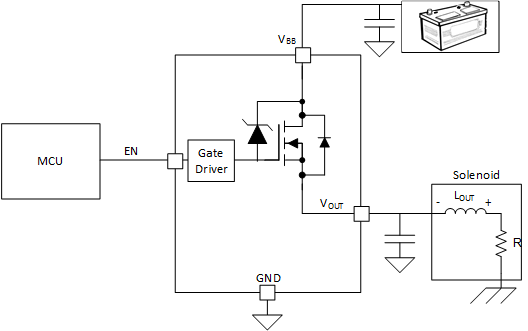SLVAE30E February 2021 – March 2021 TPS1H000-Q1 , TPS1H100-Q1 , TPS1H200A-Q1 , TPS1HA08-Q1 , TPS25200-Q1 , TPS27S100 , TPS2H000-Q1 , TPS2H160-Q1 , TPS2HB16-Q1 , TPS2HB35-Q1 , TPS2HB50-Q1 , TPS4H000-Q1 , TPS4H160-Q1
- Trademarks
- 1Introduction
- 2Driving Resistive Loads
- 3Driving Capacitive Loads
- 4Driving Inductive Loads
- 5Driving LED Loads
- 6Appendix
- 7References
- 8Revision History
4.2 Application Examples
Common inductive loads include a variety of relays and solenoids with up to 1500mH inductance and a steady state current of up to 5A. Motors and resistive loads connected with long cables, especially in industrial systems, are also inductive in their nature. One common example, seen in Figure 4-1, is driving solenoids in industrial applications like factory automation systems.
 Figure 4-1 Solenoid Application Example
Figure 4-1 Solenoid Application ExampleIn this example, the Smart High Side Switch is controlling power between a car battery and a solenoid. Solenoids are needed in automotive applications to provide a large initial current to the car engine starter so their operation is critical to turning the vehicle on. The Smart High Side Switch provides a current to the inductive coil in the solenoid which will close the contacts for the primary current to start the engine. Because this solenoid is inductive in nature it must be ensured that the Smart High Side Switch can effectively manage the challenges of both turning on and turning off the solenoid. This is a critical feature of the vehicle so proper design is necessary for the switch to operate.
Solenoids are not the only common applications that have an inductive load profile. PTC Relays, valves, electric motors, and transformers will all have a predominantly inductive load to drive. For any of these loads it is essential to ensure a proper understanding of the theory and design for an output load driving stage.